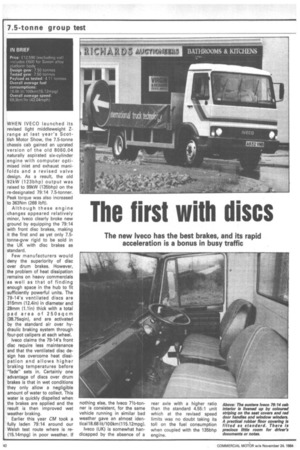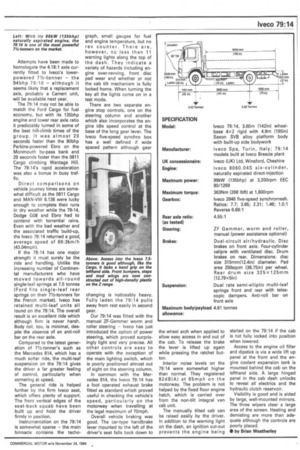The first with discs
Page 44

Page 45

If you've noticed an error in this article please click here to report it so we can fix it.
The new lveco has the best brakes, and its rapid acceleration is a bonus in busy traffic
WHEN IVECO launched its revised light middleweight Z-. range at last year's Scottish Motor Show, the 7.5-tonne chassis cab gained an uprated version of the old 8060.04 naturally aspirated six-cylinder engine with computer optimised inlet and exhaust manifolds and a revised valve design. As a result, the old 92kW (123bhp) output was raised to 99kW (135bhp) on the re-designated 79:14 7.5-tonner. Peak torque was also increased to 363Nm (268 lbft).
Although these engine changes appeared relatively minor, lveco clearly broke new ground by equipping the 79:14 with front disc brakes, making it the first and as yet only 7.5tonne-gvw rigid to be sold in the UK with disc brakes as standard.
Few manufacturers would deny the superiority of disc over drum brakes. However, the problem of heat dissipation remains on heavy commercials as well as that of finding enough space in the hub to fit sufficiently powerful units. The 79-14's ventilated discs are 315mm (12.4in) in diameter and 28mm (Min) thick with a total pad area of 2 5 Osqcm (38.75sqin), and are activated by the standard air over hydraulic braking system through four-pot calipers at each wheel.
Iveco claims the 79-14's front disc require less maintenance and that the ventilated disc design has overcome heat dissipation and allows higher braking temperatures before "fade" sets in. Certainly one advantage of discs over drum brakes is that in wet conditions they only allow a negligible amount of water to collect. This water is quickly dispelled when the brakes are applied and the result is then improved wet weather braking.
Earlier this year CM took a fully laden 79:14 around our Welsh test route where is re(15.14mpg) in poor weather. If nothing else, the Ivaco 71/2-tonner is consistent, for the same vehicle running in similar bad weather gave an almost identical18.68 lit/100km (115.12mpg).
lveco (UK) is somewhat handicapped by the absence of a rear axle with a higher ratio than the standard 4.55:1 unit which at the revised speed limits was no doubt taking its toll on the fuel consumption when coupled with the 135bhp engine.
Above: The austere lveco 79:14 cab interior is livened up by coloured striping on the seat covers and red door handles and window winders. A practical rubber floor covering is fitted as standard. There is precious little room for driver's documents or notes.
Attempts have been made to homologate the 4.18:1 axle cur rently fitted to Iveco's lower powered 71/2-tonner — the 94bhp 79:10 — although it seems likely that a replacement axle, probably a Cameri unit, will be available next year.
The 79:14 may not be able to match the Ford Cargo for fuel economy, but with its 135bhp engine and lower rear axle ratio it predictably turned in some of the best hill-climb times of the group. It was almost 20 seconds faster than the 90bhp Perkins-powered Ebro on the Monmouth by-pass bank and 29 seconds faster than the 0811 Cargo climbing Wantage Hill. The 79-14's rapid acceleration was also a bonus in busy traffic.
Direct comparisons on vehicle journey times are some what difficult as the 0811 Cargo and MAN-VW 8.136 were lucky enough to complete their runs in dry weather while the 79-14, Dodge 008 and Ebro had to contend with torrential rains.
Even with the bad weather and the associated traffic build-up, the Iveco 79:14 returned a good, average speed of 69:3km/h (43.04mph).
If the 79:14 has one major strength it must surely be the ride and handling. Unlike the increasing number of Continental manufacturers who have moved towards all-round single-leaf springs at 7.5 tonnes (Ford fits single-leaf rear springs on their 71/2-tonners for the French market). Iveco has retained multi-leaf units all round on the 79:14. The overall result is an excellent ride which although firm is never harsh.
Body roll, too, is minimal, despite the absence of an anti-roll bar on the rear axle.
Compared to the latest generation of 71/2-tonner's such as
the Mercedes 814, which has a much softer ride, the multi-leaf suspension on the 79:14 gives the driver a far greater feeling of control, particularly when cornering at speed.
The general ride is helped further by the firm !yew seat, which offers plenty of support. The front vertical edges of the seat-back squab have been built up and hold the driver firmly in position.
Instrumentation on the 79:14 is somewhat sparse — the main binnacle contains the tacho
graph, small gauges for fuel and engine temperature, but no rev counter. There are, however, no less than 11 warning lights along the top of the dash. They indicate a variety of hazards including engine over-revving, front disc pad wear and whether or not the cab tilt mechanism is fully locked home. When turning the key all the lights come on in a test mode.
There are two separate engine stop controls, one on the steering column and another which also incorporates the engine idle speed control at the base of the long gear lever. The Iveco five-speed synchro box has a well defined if wide spaced pattern although gear changing is noticeably heavy. Fully laden the 79:14 pulls away from rest easily in second gear.
Our 79:14 was fitted with the manual ZF-Gemmer worm and roller steering — Iveco has just introduced the option of power steering, which proved surprisingly light and very precise. All other controls are easy to operate with the exception of the main lighting switch, which is poorly positioned almost out of sight on the steering column.
In common with the Mercedes 814, the Iveco 79:14 has a foot operated exhaust brake fitted as standard which proved useful in checking the vehicle's speed, particularly on the motorway when travelling at the legal maximum of 70mph.
Overall vehicle braking was good. The car-type handbrake lever mounted to the left of the driver's seat falls back down to the wheel arch when applied to allow easy access in and out of the cab. To release the brake the lever is lifted up again while pressing the ratchet button.
Interior noise levels on the 79:14 were somewhat higher than normal. They registered 82dB(A) at 65mph on the motorway. The problem is not helped by the fixed floor engine hatch, which is carried over from the non-tilt integral van cab unit.
The manually tilted cab can be raised easily by the driver. In addition to the warning light on the dash, an ignition cut-out prevents the engine being started on the 79:14 if the cab is not fully locked into position when lowered.
Access to the engine oil filler and dipstick is via a wide lift up panel at the front and the engine coolant expansion tank is mounted behind the cab on the lefthand side. A large hinged panel in the cab dash unlocks to reveal all electrics and the hydraulic clutch reservoir.
Visibility is good and is aided by large, well-mounted mirrors. The three wipers clear a large area of the screen. Heating and demisting are more than adequate although the controls are poorly placed.
• by Brian Weatherley
































































































